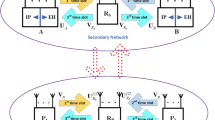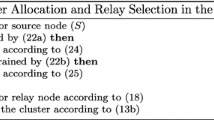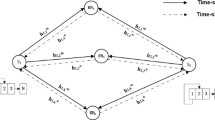Abstract
Due to the enhancement in both spectral efficiency and energy efficiency, cognitive radio (CR) being combined with relay cooperation technique is deemed as a promising way to realize green-broadband communication in the fifth generation (5G) networks. In this paper, for such CR-relay networks operating in underlay mode, when multiple secondary cognitive users (SUs) share a common cognitive relay in decode-and-forward manner to complete their physical transmissions, system power consumption is investigated. For the scenarios where the co-channel interference to primary users and the peak transmit power of SUs and cognitive relay are constrained, the problem of power allocation in CR-relay network is formulated to minimizing sum-system-consumption. Then, based on the principle that power-consumption minimization is equivalent to energy-efficiency maximization, a novel power allocation scheme is proposed. Further numerical simulation is used to verify the optimality of the proposed power allocation scheme.




Similar content being viewed by others
Change history
06 July 2020
There was a typo in the second author’s name in the initial online publication.
Notes
Under underlay cognitive mode, as secondary sources usually can not transmit their signals with their own maximal transmit power, their maximal transmit power are just considered by the allowable transmit power when co-channel interference to primary users are considered.
To simulate the scenario of cognitive relay networks, it is assumed that \(P_{i,max}^S = I_{th}/|h_{S_i,U}|^2\), \(P_{i,max}^R=I_{th}/|h_{R,U}|^2\), \(h_{R,U}\) and \(h_{S_i,U}\) are produced randomly in range (0.5, 1).
To the best of our knowledge, there is no other power allocation schemes for our considered model. Hence, in the simulation, when the equal power allocation is not feasible, our scheme is used to allocate power for secondary pairs. Consequently, the sum-system-power consumption is equal to that of equal power allocation scheme when the allowable interference is small.
References
Cheng, Y.-C., Wu, E. H., & Chen, G.-H. (2016). A Decentralized MAC protocol for unfariness problems in coexistent heterogeneous cognitive radio networks scenarios with collision-based primary users. IEEE Systems Journal, 10(1), 346–357.
Li, Z., Jiang, H., Li, P., et al. (2017). Energy-spectral-efficiency tradeoff in interference-limited wireless networks. Wireless Personal Communications, 96(4), 5515–5532.
Wang, C.-X., Haider, F., Gao, X., et al. (2014). Cellular architecture and key technologies for 5G wireless communication networks. IEEE Communications Magazine, 52(2), 122–130.
Yang, C., Li, J., Guizani, M., et al. (2016). Advanced spectrum sharing in 5G cognitive heterogeneous networks. IEEE Wireless Communications, 23(2), 94–101.
Guo, S., Pan, G., et al. (2017). Relay cooperation and outage analysis in cognitive radio networks with energy harvesting. IEEE Systems Journal,. https://doi.org/10.1109/JSYST.2016.2628862.
Liu, Y., Zhang, Y., Yu, R., et al. (2015). Integrated energy and spectrum harvesting for 5G wireless communications. IEEE Network, 29(3), 75–81.
Li, L., Zhou, X., Xu, H., et al. (2011). Simplified relay selection and power allocation in cooperative cognitive radio systems. IEEE Transactions on Wireless Communications, 10(1), 33–36.
Chatterjee, S., Maity, S. P., & Acharya, T. (2014). Energy efficient cognitive radio system for joint spectrum sensing and data transmission. IEEE Journal on Emerging and Selected Topics in Circuits and Systems, 4(3), 292–300.
Wang, S., Ruby, R., Leung, V. C. M., et al. (2016). Energy-efficient power allocation for multi-user single-AF-relay underlay cogintive radio networks. Computer Networks, 103, 115–128.
Zou, J., Xiong, H., Wang, D., & Chen, C. W. (2013). Optimal power allocation for hybrid overlay/underlay spectrum sharing in multiband cognitive radio networks. IEEE Transactions on Vehicular Technology, 62(4), 1827–1837.
Shi, Y., Zhang, L., & Chen, Z. et al, (2013). Optimal power allocation for AF full-deplex relay in cognitive radio networks. In Globecom (pp. 322–327).
Yu, H., Tang, W., & Li, S. (2012). Joint optimal sensing and power allocation for cooperative relay in cognitive radio networks. In IEEE ICC (pp. 1635–1640).
Jabeen, T., Sidhu, G. A. S., & Gao, F. (2016). A unified power allocation framework for bidirectional cognitive radio communication. IEEE Transactions on Vehicular Technology, 1, 1. https://doi.org/10.1109/TVT.2016.2587538.
Lan, P., Sun, F., Chen, L., et al. (2013). Power allocation and relay selection for cognitive relay networks with primary Qos constraint. IEEE Wireless Communications Letters, 2(6), 583–586.
Luo, C., Min, G., Yu, F. R., et al. (2013). Energy-efficient distributed relay and power control in cognitive radio cooperative communications. IEEE Journal on Selected Areas in Communications, 31(11), 2442–2452.
Lu, L., Li, G. Y., & Wu, G. (2013). Optimal power allocation for CR networks with direct and relay-aided transmissions. IEEE Transactions on Wireless Communications, 12(4), 1832–1842.
Shaat, M., & Bader, F. (2012). Asymptotically optimal resource allocation in OFDM-based cognitive networks with multiple relays. IEEE Transactions on Wireless Communications, 11(3), 892–897.
Wang, Y., Ren, P., & Gao, F. (2013). Power allocation for statistical QoS provisioning in opportunistic multi-relay DF cognitive networks. IEEE Signal Processing Letters, 20(1), 43–47.
Chen, B., Lei, M., & Zhao, M. (2016). An optimal resource allocation method for multi-user multi-relay DF cognitive radio networks. IEEE Communications Letters, 20(6), 1164–1167.
Lang, H., Lin, S., & Fang, W. (2016). Subcarrier pairing and power allocation with interference management in cognitive relay networks basde on genetic algorithms. IEEE Transactions on Vehicular Technology, 65(9), 7051–7062.
Wang, S., Ruby, R., Leung, V. C. M., et al. (2016). A low-complexity power allocation strategy to minimize sum-source-power for multi-user single-AF-relay networks. IEEE Transactions on Communications, 64(8), 3275–3283.
Wang, S., Ruby, R., Leung, V. C. M., Yao, Z., Liu, X., & Li, Z. (2017). Sum-power minimization problem im multisources single-af-relay networks: A new reivist to study the optimality. IEEE Transactions on Vehicular Technology, 66(11), 9958–9971.
Wang, S., & Liu, X. (2017). Energy-efficient power allocation for multi-user single-DF-relay networks. Wireless Personal Communications, 97(3), 3725–3742.
Kim, I., & Kim, D. (2013). Outage-constrained source-sum-power minimization in multiple-sensor single-DF-relay networks. IEEE Communications Letters, 17(7), 1388–1391.
Kim, I., & Kim, D. (2015). Minimizing operational power cost in remote-area wireless sensor networks with a DF relay and outage constraints. IEEE Communications Letters, 19(2), 247–250.
Kim, I., & Kim, D. (2012). Source-sum-power minimizing in multi-sensor single-relay networks. IEEE Communications Letters, 16(7), 1076–1079.
Acknowledgements
This work was supported by the Research Fund for the Doctoral Program of Higher Education (20120162120099). And, it was also funded by China Scholarship Council.
Author information
Authors and Affiliations
Corresponding author
Additional information
Publisher's Note
Springer Nature remains neutral with regard to jurisdictional claims in published maps and institutional affiliations.
The original version of this article has been revised: The second author’s name has been corrected.
Rights and permissions
About this article
Cite this article
Liu, X., Du, W. Energy-Efficiency-Based Power Allocation Scheme in Multi-user Single-DF-Relay Cognitive Networks. Wireless Pers Commun 114, 1927–1941 (2020). https://doi.org/10.1007/s11277-020-07455-3
Published:
Issue Date:
DOI: https://doi.org/10.1007/s11277-020-07455-3




